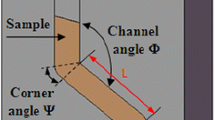Abstract
A photoelastic investigation is conducted for plane wedge-shaped dies with special reference to the distribution of pressure and friction on the contact surface.
A softened celluloid strip is drawn through the gap of Araldite dies kept in the state of glassy elastic. The results are compared with the theoretical results by other investigators.
Similar content being viewed by others
References
Hoffman, O., and Sachs, G., “Introduction to the Theory of Plasticity for Engineers,” McGraw-Hill Book Co., Inc., 189 (1953).
Green, A. P., andHill, R., “Calculations on the Influence of Friction and Die Geometry in Sheet Drawing,”Jnl. Mech. Phys. Solids,1,31–36 (1952).
Frocht, M. M., and Thomson, R. A., “Studies in Photoplasticity,” Proc. 3rd U. S. Natl. Congr. Appl. Mech., 533–540 (1958).
Author information
Authors and Affiliations
Rights and permissions
About this article
Cite this article
Ohashi, Y., Nishikiori, K. Photoelastic investigation of plane wedge-shaped drawing die. Experimental Mechanics 6, 171–176 (1966). https://doi.org/10.1007/BF02326146
Issue Date:
DOI: https://doi.org/10.1007/BF02326146




